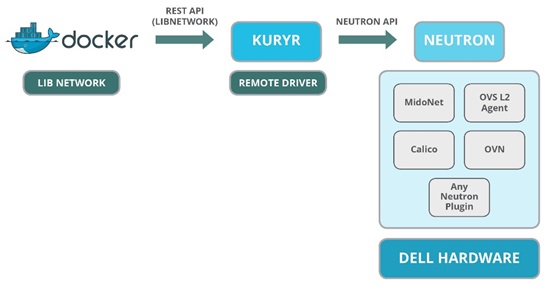Ed. Note: This blog was co-authored by Don Root, Dell Networking Product Marketing and Ashish Mukharji, Midokura Director of Business Development
Those of us fortunate to have worked in networking for a few decades got to watch the early days of packet switching development, and on that technological foundation, the explosion of the World Wide Web, as well as the development of new enabling technologies like virtualization and cloud.
These days, the hottest new trend is the concept of packaging an application into a software “container” that can be deployed anywhere. Even more lightweight than virtual machines, containers release application developers from worrying about the ins and outs of any specific system software, and provide operators with a faster and less resource-heavy virtualization option.
Kuryr provides the established Neutron framework for containers
The container boom is having a huge impact on the infrastructure space. Indeed, containers are on a growth curve to equal or surpass OpenStack. Industry pundits agree that both technologies are here to stay, and that they can and must coexist – coopetition rather than competition. Industry heavyweights including Red Hat and VMware have come out in support of both containers and OpenStack, and the OpenStack Magnum project was introduced specifically to support containers.
As is so often the case with open source technologies, the popularity of containers has led to a boom in the number of approaches to provide container networking, particularly in heterogeneous environments, e.g. mixing containers and OpenStack. These technologies are relatively new and immature, and each technology takes its own idiosyncratic approach to solving a variety of common IT problems. Repeating a story we’ve so often seen in the open source world, fragmentation looms as the biggest threat to success.
Project Kuryr, led by Midokura, a global leader in network virtualization, had a better idea: the OpenStack Networking “Neutron” framework already exists, is stable, enterprise-capable, and widely accepted. Rather than reinvent the wheel multiple times, why not bring Neutron to containers as a single unifying networking model? Neutron already has a rich ecosystem of plugins and drivers to provide network services like LBaaS and FWaaS. In concrete terms Project Kuryr maps Docker libnetwork to the Neutron API, allowing container operators to take advantage of the services available to Neutron. Best of all, Kuryr provides a single focus for future development and innovation on container and OpenStack networking.
And Kuryr is already backed by an impressive lineup of corporate sponsors: Huawei, IBM, VMware, Mirantis, Imaginea and Comcast.
Optimized and cost-effective networking for containers
Dell partnered with Midokura in December of 2014 to expand its Open Networking initiatives with Midokura’s Enterprise MidoNet software running on Dell networking switches. MidoNet provides a software-based, highly distributed network virtualization system for OpenStack and Neutron compatible environments. Dell’s open networking switches offer an innovative, disaggregated-hardware/software solution for demanding data center networking infrastructures like containers. Customers have the choice of running Dell or third party operating systems such as Cumulus Linux on proven and globally supported switches to meet their specific application and management needs.
Summary
Project Kuryr connects two of the hottest trends in cloud computing: OpenStack and containers, providing developers with a single codebase and a united set of goals to focus their development efforts. The result is greater standardization and ease of use, leading to increased business value, and therefore quicker deployment and acceptance within the enterprise.
